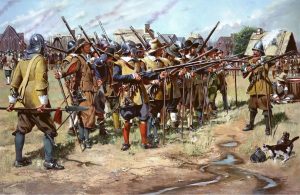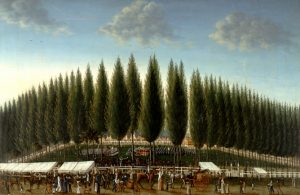The Washington Arch on the Salem Common
Early History: the Salem Common and Its Militia Legacy
The Salem Common has been public land since Salem’s early days in the 1600’s. Originally, much of its acreage was ponded and swampy, but a portion of it, drier land at a higher elevation, was suited to practice shooting and drill training. Here, Captain John Endicott organized the first training day for the local band of militia in 1630, at a time when colonial law required all males between the ages of 16 and 60 to possess arms and be prepared to participate in the defense of their settlements. Regularly scheduled militia drills by the “East Regiment” began in 1637, an event known as the First Muster (commemorated in the Don Troiani painting shown below), and represented the first time that a multi-community area brought together such a force to engage in drill training for the common defense, thus laying the foundation for what became the Army National Guard. Militia training on the Common continued into the Eighteenth Century, and in 1714 the town acted to officially confirm that the Common would be “forever kept as a training field for the use of Salem.” This martial legacy continued into the Revolutionary War period, when personnel from Salem participated in key events on land and at sea.
Name and Image: President Washington’s Lasting Impression on the Common
General George Washington, through his popularity as a military leader and statesman, used his first year as president to personally tour each of the 13 states in order to build national unity. On October 29, 1789, General Washington visited Salem to thank those on the North Shore for their part in the Revolution. He rode into Salem mounted on a white horse to the sound of church bells and cannon fire from Winter Island. Huge crowds followed the celebrations as he reviewed the troops, was feted with speeches downtown, attended a Ball at the Assembly House, and watched a fireworks display in his honor.
More than ten years later, in 1801, Salem’s Elias Hasket Derby (the 2nd), who was a colonel in the militia, led a committee to raise $2,500 to improve the condition of the Salem Common. Ponds were filled in, the surface levelled, and rows of poplar trees were planted. The following year, by order of the town selectmen, the Common was renamed Washington Square in honor of the nation’s first President. Park improvements continued with the erection of gates and a fence. Samuel McIntire, Salem’s distinguished woodcarver and self-taught architect, was commissioned in 1805 to design and construct four gateways for the four entrances to the Common. These included two elaborate and embellished arches (East and West) and two turnstiles (North and South). The main gateway (the West Arch) was designated the “Washington Arch” and was located on the westerly side of the Common at the head of Brown Street. McIntire molded his designs based on those used in ancient Rome in triumphal processions. The Western arch featured ornate carvings, including an oval portrait of Washington flanked by swags of drapery, the Massachusetts state emblem, and a gold eagle to symbolize the recently formed United States of America.
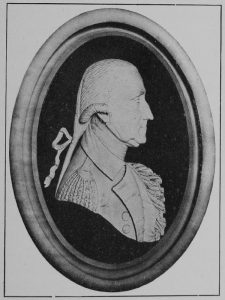
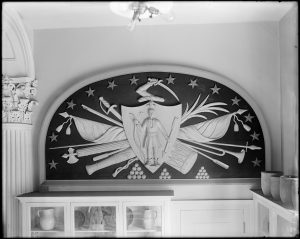
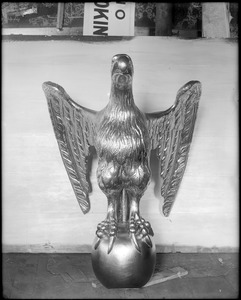
The abutting land quickly became desirable for residential use and an upscale neighborhood grew. For two decades thereafter, a number of the city’s leading merchants built imposing Federal mansions facing the Common. Houses in various revival styles were later built on remaining lots, resulting in an impressive concentration of early to mid-19th century dwellings, many of which remain today. George Ropes Jr.’s painting, Salem Common on Training Day (1808), is a beautiful reminder of Salem’s new center of community activity. Annual Training Day brought local militia units from neighboring towns and communities parading in dress uniform through Salem streets to meet at the Common. Memoirs of early Salem residents fondly describe this day of colorful parades, puppet shows, athletic events and socializing. Unfortunately, all the poplar trees (pictured) were destroyed in 1815 by a great gale and were replaced with elms and maples several years later.
On August 31, 1824, one of George Washington’s most influential generals during the Revolutionary War, the Marquis de La Fayette, received a hero’s welcome in Salem. Despite the rain, thousands of people came to Washington Square to celebrate their famous guest. In 1850, the Common was again remodeled adding walkways and the cast iron fencing. The arches were removed at this time, and McIntire’s carvings (with the exception of the drapery swags) were saved, eventually entering the collection of the Peabody Essex Museum (PEM). Below are two of the relatively few images made of the original arch which have survived to the present.
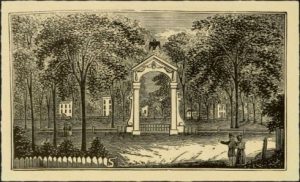
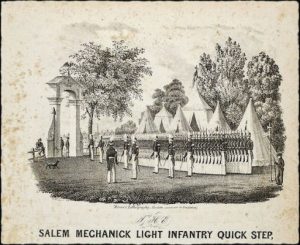
1976: Renewal with the Bicentennial
The Salem Common’s cast iron fence was listed on the National Register of Historic Places in 1976. That same year, the Bicentennial Commission authorized the construction of a scaled-down replica of the Washington Arch which had stood astride the western entryway of the Common’s old wooden fence enclosure. This replica was constructed of metal and wood and located at the corner of Washington Square South, facing where the Tavern at the Hawthorne Hotel is now. With respect to McIntire’s decorative carvings, it bore copies of Washington’s oval portrait, flanked by curtain swags, and the martially adorned state seal, but the mounted eagle was omitted.
Carl Peterson contributed the architectural drawing for the replica. Ramon Parga of Salem led the overall fabrication project supported by skilled woodcarvers including international experts such as Leslie Martin Randell. The 101st Battalion National Guard Corps of Engineers of Reading MA — the lineal descendant of the East Regiment — provided expertise with respect to the steel fabrication and construction. Johannes Maki was the project supervisor. Reno Pisanno served as consultant. James Kieran and Richard Redfern were the carpenters; They were assisted by the staff of the Essex Institute (now PEM) who contributed substantially to the venture. Mayor Levesque formally dedicated this new “Washington Arch” on July 4th, 1976. In the decades that followed, neglect took a toll on the structure and decorations. (See images below.)
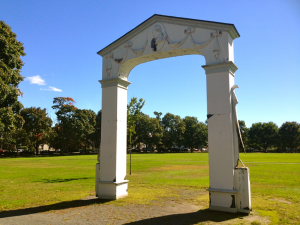
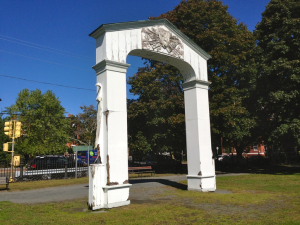
The 21st Century: A Campaign for Restoration
In 2013, Winter Street Architects created a detailed report on the Arch’s history, restoration parameters, and needs, which lent a direction for the structural repairs that followed.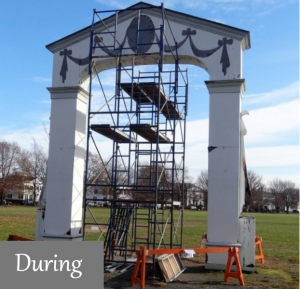 That same year, President Obama signed Public Law 112-241 that named Salem as the birthplace of the National Guard in 1637.
That same year, President Obama signed Public Law 112-241 that named Salem as the birthplace of the National Guard in 1637.
Years of study, organizing, and fundraising by the SCNA, in alliance with many dedicated public servants and community members, culminated in a set of major achievements for restoration of the Washington Arch up to, and even during, the COVID-19 pandemic. A brick masonry pathway was laid beneath the Arch, complete with a radial north-south walkway and a rose compass directly under the span, as well as irrigated garden beddings for plantings. An explanatory sign was placed by the pathway, with accessibility in mind. Perhaps most portentously, state funds combined with those of the SCNA secured the work of the estimable Skylight Studios (of Woburn, Massachusetts) in restoring scaled replacement carvings of the Washington oval portrait and curtain swags, and the crown-emplaced gilded eagle. (The treatment of the state seal awaits a government effort to re-examine the imagery in use.)
To this day, the National Guard hosts their annual Muster on the Common in honor of their founding as well as Washington’s original visit. With full restoration, the Washington Arch can serve as a focal point for these ceremonies. Active duty members and veterans of the Guard have been especially solicitous in efforts to care for the Salem Common in general and, in particular, to repair and restore the Washington Arch and its carvings.
The Future: Received from the Hands of Many
Over the years, many organizations and citizens have helped with the ongoing Arch restoration including but not limited to:
Salem Mayor Kim Driscoll; Salem Veterans Council; City Councilor Michael Sosnowski; Richard T. Laperchia & Alpine Woodworks; Boy Scout Troop 24; Waters and Brown; Salem 5 Bank; Mark Meche & AIA/Winter Street Architects; Lions Club; Scottish Rite & Essex Lodge Freemasons; Kearsarge Lodge # 217; Eastern Bank; Lodge #118 Odd Fellows; The Salem Witch Museum; Essex Heritage and the City of Salem. The efforts of the SCNA board and members past and present are gratefully acknowledged, particularly those of Peter LaChappelle.
Through the hard work and dedication of City Staff working closely with the SCNA’s Board and Members, supported by the generous contributions of our donors, the Washington Arch still stands as an important symbol of a proud historical tradition. Please consider donating to help keep this restoration a reality for our future generations and donate using the button below.
